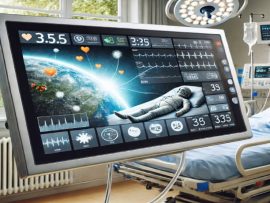Abstract Background Limb ischemia is a serious complication of venoarterial (VA) extracorporeal membrane oxygenation (ECMO), potentially resulting in amputation, rhabdomyolysis, or death. This study aimed to evaluate the effectiveness of..
Read MoreAbstract The main objective of this study is to evaluate the low-cost, open-source HEGduino device as a tissue oximetry monitor to advance the research of somatic NIRS monitoring. Specifically, this..
Read MoreAbstract Introduction Postoperative acute kidney injury (AKI) is a common postoperative complication in cardiac surgery, with varying reported incidences and prognostic factors. Renal hypoperfusion is believed to be a key..
Read MoreAbstract Extracorporeal membrane oxygenation (ECMO) is a medical device that provides temporary external circulation and respiratory support during heart-lung procedures, substituting for heart and lung function to alleviate their burden..
Read MoreAbstract Introduction We sought to evaluate cerebral and somatic oximetry in an integrated tissue perfusion monitoring strategy. Method Thirty adult patients undergoing full-spectrum cardiac surgery with Minimal Invasive Extracorporeal Circulation..
Read MoreAbstract Background Current indicators for monitoring intraoperative organ function remain predominantly indirect, delayed and non-specific, particularly in paediatric populations undergoing congenital heart surgery, where multifactorial influences further complicate functional assessments. Emerging..
Read MoreAbstract Background and Objective: Effective cerebral perfusion monitoring is essential in aortic arch surgery, particularly when employing the Kazui technique under moderate hypothermia. Near-infrared spectroscopy (NIRS) provides real-time regional oxygen..
Read MoreAbstract Background Near-infrared spectroscopy (NIRS) enables a non-invasive measurement of tissue oxygen saturation (StO2) in regions illuminated by near-infrared lights. Vascular occlusion test (VOT) serves as a model to artificially..
Read MoreAbstract Objective: We aimed to evaluate the effects of cardiopulmonary bypass (CPB) machines used in coronary artery bypass grafting surgeries on cerebral perfusion by performing cerebral oximetry monitoring [near-infrared..
Read MoreAbstract We aimed to determine the association between cerebral regional oxygen saturation (rSO2) trends from cerebral near-infrared spectroscopy (cNIRS) and acute brain injury (ABI) in adult venoarterial extracorporeal membrane oxygenation (VA-ECMO) patients. ABI was defined as..
Read MoreAbstract OBJECTIVES: Near-infrared spectroscopy (NIRS) has been increasingly accepted as a noninvasive marker of regional tissue oxygenation despite concerns of imprecision and wide limits of agreement (LOA) with invasive oximetry. New generation absolute..
Read MoreAbstract Backgroundː Impairment of cerebral autoregulation (CA) has been observed in patients undergoing cardiopulmonary bypass (CPB), but little is known about its occurrence and associations with outcomes. The objective of this..
Read MoreAbstract Objective Currently, several near-infrared spectroscopy oximetry devices are used for detecting cerebral ischemia during cardiopulmonary bypass (CPB) surgery. We investigated whether two different models of near-infrared spectroscopy oximetry devices..
Read MoreAbstract Premature birth, defined as a gestational period less than 37 weeks, occurs in 8% of infants born in Canada. These births are associated with a higher risk of developing..
Read MoreAbstract Baseline cerebral regional saturation (rSO2) measured using the INVOS 5100C (Medtronic, MN, USA) varies widely among patients with cardiac and/or renal diseases. To identify significant correlates of baseline rSO2 and..
Read MoreAbstract OBJECTIVES: Monitoring cerebral autoregulation may help identify the lower limit of autoregulation in individual patients. Mean arterial blood pressure below lower limit of autoregulation appears to be a risk..
Read MoreAbstract Objectives: To evaluate the value of perioperative cerebral near-infrared spectroscopy monitoring using variability analysis in the prediction of neurodevelopmental outcomes in neonates undergoing surgery for congenital heart disease. Design: ..
Read MoreAbstract Objectives Patients with are at risk for neurodevelopmental impairment. during neonatal treatment might be a relevant cause. We evaluated the association between cerebral oxygenation in the perioperative course of the and neurodevelopmental..
Read MoreAbstract The aim of the present study was to investigate whether changes in hepatic oxygenation can be detected by time-resolved spectroscopy (TRS) placed on the skin surface above the liver...
Read MoreAbstract Objective Cardiac surgery and are associated with release of and microcirculatory alterations that result in organ dysfunction. Near-infrared of tissue (StO2) and the test (VOT) were utilized in a study of elective cardiac surgical..
Read MoreAbstract Cerebral and somatic near-infrared spectroscopy monitors are commonly used to detect tissue oxygenation in various circumstances. This form of monitoring is based on tissue infrared absorption and can be..
Read MoreAbstract The long-term neurodevelopmental outcome has been a great concern for cardiac surgeons although it is still unclear. There are some risks regarding the neurological and neuropsychological deficits before, during..
Read MoreAbstract Neurologic injury in the form of cognitive decline, delirium, and stroke are common phenomena in patients undergoing cardiac surgery and continues to be one of the most common complication..
Read MoreAbstract Purpose of review There is an increasing interest in the application of near-infrared spectroscopy (NIRS) as a monitoring tool in noncardiac surgery. This review summarizes the latest developments and..
Read MoreAbstract Background: We designed a non-invasive, observational, real-time study, using near-infrared spectroscopy (NIRS) to assess the in vivo effects of cardiopulmonary bypass (CPB) on patients’ skeletal muscle as well as..
Read MoreAbstract Objectives: Cardiac surgery–associated acute kidney injury is common in children and associates with negative outcomes. Novel interventions to reduce cardiac surgery–associated acute kidney injury require knowledge of its pathophysiology...
Read More










